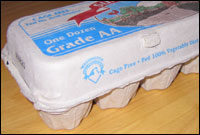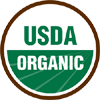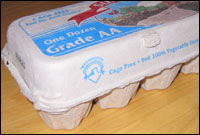“What’s in a name?” asks Shakespeare. Conscientious food consumers are beginning to realize that the answer too often is, “Not much.”

Eggsellent.
Shoppers increasingly are willing to pay more for food produced in a way that protects human health, water, wildlife, rural communities, and farm workers. And this is not lost on marketers. Many grocery packages today include “eco-labels” that make attractive claims. Grocery shelves are bulging with food labeled “Natural,” “Free-Range,” and “Sustainable.”
But much of this labeling is just spin. “Free-Range” chicken conjures an image of birds pecking contentedly around a farmhouse. In reality, Department of Agriculture standards for the label stipulate only that the chickens must have access to the outdoors for an undetermined period each day.
Such is today’s supermarket aisle. So how does a shopper make informed decisions?

Seal of approval.
It is important to distinguish between label types. Some, such as “USDA Organic,” indicate verified compliance with exacting federal standards. Other claims, such as “Natural” and “Hormone-Free,” also have federal standards but are not subject to verification. (Many such general claims are currently under consideration for more defined, and enforced, standards.)
A number of eco-labels are not administered by the federal government, but instead are governed by trustworthy independent verification boards that should ensure the food is produced a certain way. Examples include “Protected Harvest,” “Salmon-Safe,” and “Predator-Friendly.”
But other labels may mean nothing close to what they suggest.

Buyer beware.
For example, the Hudson Institute’s Center for Global Food Issues recently announced the label “Earth Friendly, Farm Friendly” for dairy producers and processors that follow its industrial, corporate agenda for food production. The center attacks organic agriculture and applauds genetically modified food. Its website promotes feedlots, with one story claiming that cows are “more than happy to stand with their friends on a cement feedlot floor (protecting the ecosystem).” Appearing next to the “Earth Friendly” label promotion is an ad for a book titled Saving the Planet With Pesticides and Plastic, written by the center’s director, Dennis Avery.
Not exactly most people’s idea of being friendly to the earth or the farm.
Clearly, making responsible choices requires reading beyond such labels, understanding our agricultural economy, and becoming familiar with producer practices.
Eco-labels can be researched on the web. The sponsors of reliable labels, including “Protected Harvest” and “Salmon-Safe,” are transparent in their practices. The Consumers Union’s Guide to Environmental Labels rates nearly all of them. Dan Imhoff’s excellent book Farming with the Wild includes a section devoted to valid eco-labels and what they mean.
And there is still no substitute for actually learning about how food is produced and becoming personally vested in our agricultural system. By selecting locally produced food, consumers can more easily verify how their food is produced and support their local economy. They can talk with farmers at farmers’ markets, seek out increasingly common local food guides, and take part in farm tours.
This is more difficult than feeling good about ourselves by picking something off the supermarket shelf simply because it proclaims purity and goodness. But our health and that of our children, our wildlife, our soil, and our water depend on consumers looking beyond fashionable labels that too often are much ado about nothing.


